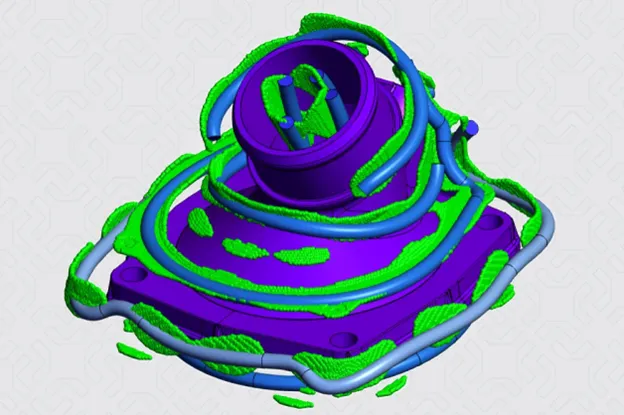by Arnaud Divialle
The plastic molding industry now demands a continuous and proactive approach. As industry veteran Scott Peters discussed with us recently, many enterprises are actively exploring avenues to optimize and streamline their operational processes. A critical aspect of this optimization relates to the development process for plastic compression and injection molds. The design phase typically requires less than one week, but a significant bottleneck often arises when companies must wait one or two weeks to obtain results from mold flow analysis (MFA) before they can finalize mold design.
Given the substantial costs and lead times associated with MFA, many companies refrain from conducting it on every mold, unless explicitly mandated by their clients. Instead, they rely on intuition to make design decisions and only selectively opt for MFA on “critical” molds. Companies must strike a delicate balance between the potential risk of wasting valuable time and resources on MFA and the peril of accepting defective molds that could require even more time and expense to rectify afterward.
However, compression and injection mold optimization is within reach: an upfront software simulation can help you get the ideal cooling line designs in place before production begins.
Strategic simulation software

Some forward-thinking Mold Makers and MFA service providers are adopting SimForm — an intuitive, cloud-based mold cooling simulator software — as a strategic tool to swiftly assess molds. Using SimForm empowers these firms to ground decisions in scientific data, not intuition, when determining whether a full MFA would contribute tangible value. This methodology mitigates risk by presenting a systematic, cost-effective, and efficient means of justifying the expenses and lead time associated with mold flow analyses.
SimForm facilitates MFA service providers’ efforts to explain the necessity for additional in-depth simulations to their clients. At the same time, it also empowers mold makers to justify to their own customers, including molders and OEMs, why further analyses may not be warranted. This dual functionality of SimForm serves to optimize overall tool development costs and lead times.
Unlike traditional simulation tools that require days of setup, compute time, and expert oversight, SimForm provides quick insight in under 15 minutes. This kind of speed in early mold cooling simulations helps teams evaluate the mold & part thermal gradients and understand the part temperatures before mold layouts have been finalized. As a result, they can prioritize areas for deeper analysis — and save resources that would otherwise be wasted if late-stage simulations and physical tests lead to costly and time-consuming rework.
For example, a mold maker evaluating five design options can run SimForm thermal simulation software on each and rapidly identify the two most promising concepts to forward for full MFA. This approach preserves both time and budget and can prevent late-stage design changes that delay final tooling.
SimForm also helps to build trust across the stages of the product supply chain. Molders and OEMs appreciate when mold makers provide data to back up their initial design decisions. When a mold maker uses SimForm, they’re able to show thermal maps and predicted cooling times. This helps make that decision understandable — and defensible — from a technical and business standpoint.
Use cases across the value chain

The strategic role of SimForm isn’t limited to mold makers and MFA providers. The tool supports a range of decision-makers throughout the manufacturing chain:
- Designers can use simulation software to evaluate temperature behavior inside the mold in just 15 minutes based on a few initial parameters and before the design is complete or steel is cut. This eliminates many known design process inefficiencies, so the mold engineering team can optimize cooling line placement beforehand and save on costs.
- Molders and parts manufacturers can simulate and validate production scenarios to spot and correct issues before they happen. The result is faster part delivery time, potentially by multiple weeks.
- OEMs can use it during early-stage design reviews to quickly assess the part design and make sure it’s easy to manufacture before sending out RFQs to their suppliers. Confidence that part cost is low (and that they’ll get the parts earlier) keeps the production budget and timeline under control.
Early integration of SimForm simulation software in the workflow helps all of these stakeholders create a more transparent, efficient process. There’s nothing to lose — except the finger-pointing, rework, and surprises that come with an outdated trial-and-error approach.
The long-term value of technology

Decisions driven by SimForm are rooted in engineering simulation data. Ultimately, these are far more justifiable and less open to debate than intuition, no matter how experienced. For MFA service providers and mold makers alike, strategically adopting simulation technologies marks a significant step toward enhancing efficiency and reducing uncertainties in the plastic injection industry.
There’s also a long-term strategic value in making data part of the everyday design conversation. As senior experts retire and new engineers come in, institutional knowledge must be backed up with tools that reinforce best practices. SimForm gives new team members a way to learn quickly and validate their thinking, helping to preserve quality as teams change. SimForm represents exactly the type of efficiency-driving industry innovation that Plastics Today says mold manufacturers are embracing to combat economic challenges, including, “continuous improvement efforts, personnel development, and investing in new or updated equipment.”
Even experienced engineers find simulation software like SimForm helpful as a second set of eyes. It’s a way to check assumptions, confirm thermal behavior, and validate that your instincts are aligned with physics. As Scott Peters put it in our conversation, “It’s about replacing guesswork with fast feedback you can trust.”
Learn more
To discover for yourself the value SimForm can bring to your services, sign up for a free trial today.